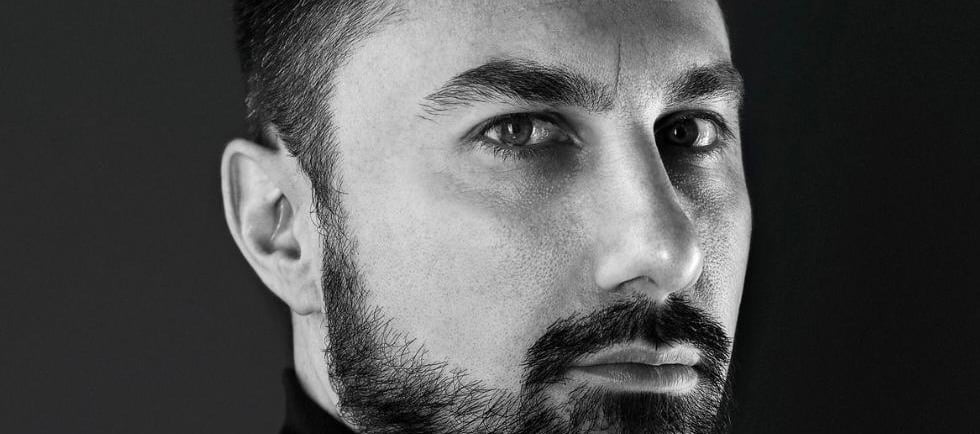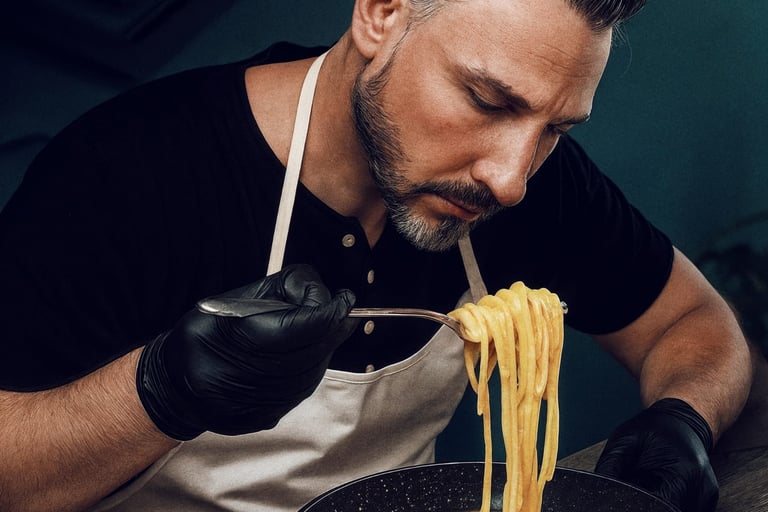Carbonara Dascanio – Official Recipe. A slow-cooked act of love
This isn’t a dish, it’s a manifesto. Every move is deliberate, every ingredient chosen with surgical precision. The pasta is structure, the pancetta is rhythm, the egg is atmosphere. In this carbonara, there’s no room for shortcuts: no cream, no noise. Just raw matter, shaped with the same obsession for light and detail that Emanuele Dascanio pours into his drawings. A creation to be savored like a masterpiece is contemplated: in silence, with reverence, down to the very last bite.
MASTERCHEFS & MASTERPIECES
Charlotte Madeleine Castelli & Emanuele Dascanio
6/21/20253 min read


There are artists who narrate the world, and others who recreate it—returning to us what we thought was lost: the sacredness of gesture, the silence of passing time, the kind of light that doesn’t just illuminate but reveals.
Emanuele Dascanio is this. He is a fissure in the present through which eternity slips.
I first came to know him through the raw material of his work: patience.
His hyperrealism is never a display of mere virtuosity, but rather an act of devotion. His works do not imitate reality—they question it, excavate it, purify it. Graphite, charcoal, oil: humble tools that, in his hands, become a liturgy. Every detail is a slow prayer, every portrait a vertigo, every shadow a secret.
To look at a work by Dascanio is not to observe an image, but to witness time made visible and alive. A breath that belongs neither to the past nor the present, but to some other dimension, where technical perfection bends to emotion. His faces, his hands, his allegorical bodies speak to us of destiny, identity, memory. And they do so without shouting—with the silent force of the classics.
His formation has deep roots: from the Milanese schools to his meeting with Master Gianluca Corona, to his rigorous assimilation of Renaissance technique. Yet Dascanio has never lingered in nostalgia. He has embraced the present, exploring digital frontiers, giving body and soul even to code and blockchain—without ever losing the sacredness of craftsmanship.
There are works of art that aren’t merely admired with the eyes — they’re savored with the soul. Just as Emanuele Dascanio sculpts light within the precision of his hyperrealism, this carbonara takes shape gesture by gesture, with no excess, no shortcuts — only patience, gentle heat, and absolute devotion.
This isn’t a recipe; it’s a silent performance. Every step is a charcoal stroke, deliberate, controlled. The spaghetti, a thin line drawn on paper; the crispy pancetta, a bright brushstroke; the creamy, enveloping egg, pure chiaroscuro. And just like Dascanio’s art, what you don’t see is what truly matters: no cream, no distractions. Just truth.
For Dascanio, time is sacred. And here, too, we slow down. We listen to the whisper of the oil, we honor the boiling water as if it were an orchestral overture. Carbonara Dascanio is generous — because beauty, like happiness, can’t be measured by the gram. It’s a celebration of togetherness and of what is essential, where each bite feels like a finished canvas: complete, moving, necessary.
Prepare yourselves... Because here, among oil, eggs, and spaghetti, a small everyday masterpiece is born.
Carbonara Dascanio – Official Recipe
A celebration of conviviality, abundance, and perfect simplicity
---
Ingredients (for a generous portion):
Spaghetti No. 7: 200 g per person (at the very least!)
Very fresh eggs: 1 and a half per person
High-quality smoked pancetta: in generous amounts
Extra virgin olive oil: as needed, both for cooking and raw
Coarse salt: 1 heaping tablespoon per liter of water
Grana Padano (optional): freshly grated, to taste
_____________________________________
Method:
1. Water, first of all.
Start here. Fill a large pot with plenty of water and salt it generously: 1 heaping tablespoon of coarse salt per liter. Bring to a boil.
2. Pancetta, queen of anticipation.
Meanwhile, cut the pancetta into strips or cubes. In a pan, brown it in hot extra virgin olive oil until fragrant and crispy. Then turn off the heat and remove any excess oil — what should remain is its soul, not its fat.
3. The pasta moves.
When the water boils, drop in the spaghetti. The first 4 minutes are sacred: stir constantly to prevent sticking. Cook for 11–12 minutes, depending on your taste and the brand you use.
4. A return to the source.
Drain the pasta and return it to the still-warm pot. Immediately add the crisped pancetta, a generous drizzle of raw extra virgin olive oil, and the beaten eggs: 1 and a half per person (e.g., 3 eggs for 2 people; 4 and a half for 3, and so on).
5. The art of mantecatura.
Turn the heat back on — very low. Stir patiently: the egg shouldn’t cook, but embrace the pasta, becoming creamy, golden, enveloping. If it begins to scramble, you're just a breath away from perfection.
6. The moment of truth.
Plate and serve immediately. Carbonara Dascanio waits for no one.
With the first bite, you may realize — nothing is missing anymore.
_________________
Final note
No cream. No onion. No garlic.
Only truth, slow fire, and passion.
A dish not measured in calories, but in smiles.
To be his curator is, each time, to rediscover the meaning of an ancient word: artifex—one who creates with art, but also with faith.
© Charlotte Madeleine Castelli | All rights reserved


